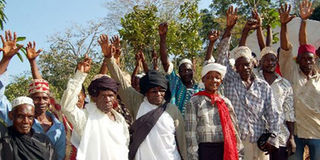Poor in the midst of plenty

Kaya elders from Mrima in Kwale County pledging to support Niobium mining in the area by Cortec Company on March 30, 2012. Photo/FILE
What you need to know:
- Kajiado is said to be the richest with a poverty index of 11.6 per cent.
- Kwale County has vast high potential agricultural land interspersed with hills, tropical forests, arid lands and the Indian Ocean.
- The county also boasts of golden sandy beaches ideal for investment in the hospitality and tourism sector.
Kwale County located in the south eastern tip of Kenya borders Tanzania to the south-west around Lunga Lunga and Vanga.
To the west and north west, it borders Taita Taveta County while to the north and north east it borders Kilifi County.
It also shares borders with Mombasa County to the east and the Indian Ocean to the east and south east.
It receives ample rainfall to make commercial and subsistence farming viable but despite its huge potential in agriculture, mining, tourism and a host of other natural resources, Kwale County remains one of the poorest in the country.
The county is ranked the 7th poorest in the country with a poverty index of 74.9 per cent. The poorest county according to the government’s assessment data of 2005/6 and 2009/2010 is Turkana with a poverty index of 94.3 per cent.
Kajiado is said to be the richest with a poverty index of 11.6 per cent.
The poverty ranking is as follows -: Turkana (94.3 per cent), Marsabit (91.7 per cent), Mandera (87.8 per cent), Wajir (84 per cent), Malindi (76 per cent) and then Kwale (74.9 per cent). In trms of wealth, Kajiado tops the list followed by Kiambu, and Nairobi
High Potential
Kwale County has vast high potential agricultural land interspersed with hills, tropical forests, arid lands and the Indian Ocean.
The county also boasts of golden sandy beaches ideal for investment in the hospitality and tourism sector. Indeed, the county is home to some of the most luxurious five-star tourist hotels in Africa.
The Shimba Hills National Reserve, with its rich rain forests, woodlands and grasslands found further in the hinterland and the famous Mwalughanje Elephant Sanctuary near Kwale town are havens of tranquility and serenity and major tourist attractions.
The Mwalughanje Sanctuary is also home to a rare antelope – the Sable – which is only found in Kwale county. The county also boasts of numerous cattle ranches, many of which are leased to pastoralist herders from North Eastern Kenya and Tana River.
The county has vast deposits of unexploited minerals, plenty of arable land and huge fishing resources that are yet to be tapped. The list of the county’s natural riches is endless but exploitation for the betterment of the local communities is yet to be done.




